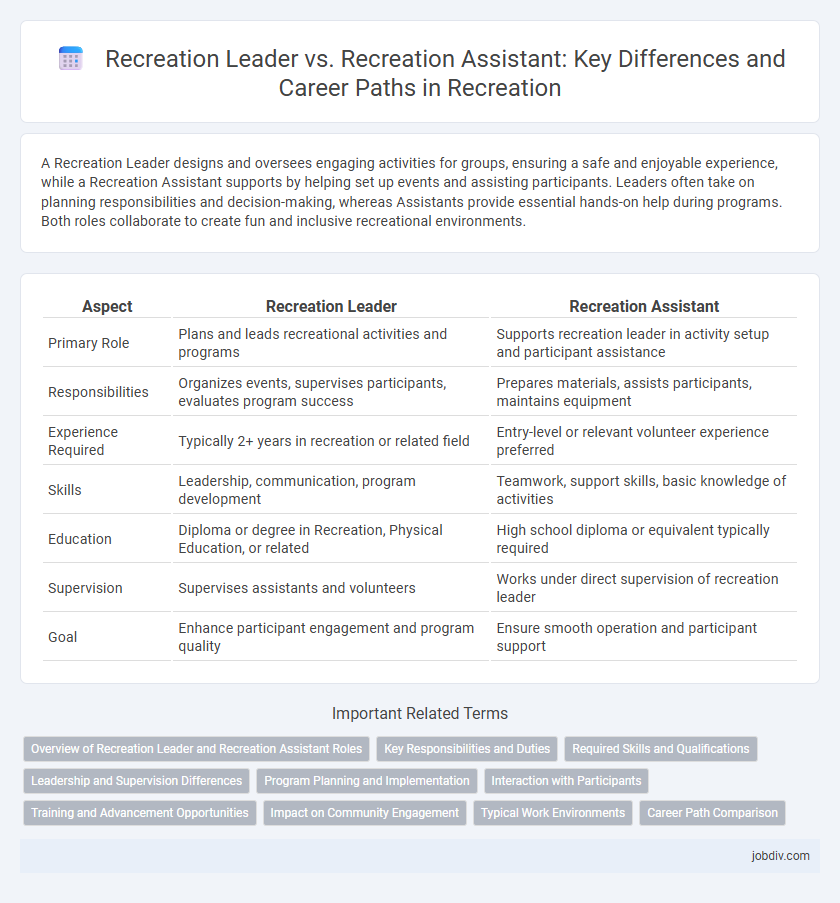A Recreation Leader designs and oversees engaging activities for groups, ensuring a safe and enjoyable experience, while a Recreation Assistant supports by helping set up events and assisting participants. Leaders often take on planning responsibilities and decision-making, whereas Assistants provide essential hands-on help during programs. Both roles collaborate to create fun and inclusive recreational environments.
Table of Comparison
| Aspect | Recreation Leader | Recreation Assistant |
|---|---|---|
| Primary Role | Plans and leads recreational activities and programs | Supports recreation leader in activity setup and participant assistance |
| Responsibilities | Organizes events, supervises participants, evaluates program success | Prepares materials, assists participants, maintains equipment |
| Experience Required | Typically 2+ years in recreation or related field | Entry-level or relevant volunteer experience preferred |
| Skills | Leadership, communication, program development | Teamwork, support skills, basic knowledge of activities |
| Education | Diploma or degree in Recreation, Physical Education, or related | High school diploma or equivalent typically required |
| Supervision | Supervises assistants and volunteers | Works under direct supervision of recreation leader |
| Goal | Enhance participant engagement and program quality | Ensure smooth operation and participant support |
Overview of Recreation Leader and Recreation Assistant Roles
Recreation Leaders plan, organize, and supervise recreational activities and programs aimed at promoting community engagement and physical fitness, often taking a leadership role in coordinating events and managing staff. Recreation Assistants support these initiatives by assisting in the setup, execution, and cleanup of activities, providing direct participant assistance, and ensuring safety protocols are followed. Both roles contribute to enhancing recreational experiences but differ primarily in responsibility level and scope of duties.
Key Responsibilities and Duties
Recreation Leaders oversee planning, organizing, and leading activities, ensuring participant safety and engagement while managing group dynamics. Recreation Assistants support leaders by preparing equipment, setting up venues, and assisting participants during activities. Both roles collaborate to deliver a positive recreational experience but differ primarily in leadership and supervisory responsibilities.
Required Skills and Qualifications
Recreation Leaders typically require strong leadership skills, certification in CPR and first aid, and experience in program planning and supervision, often holding a degree in recreation management or a related field. Recreation Assistants need basic knowledge of recreational activities, good communication skills, and certificates in safety protocols, with on-the-job training sufficing in many cases. Both roles demand physical fitness and the ability to engage diverse populations, but Recreation Leaders carry greater responsibility in coordinating activities and managing staff.
Leadership and Supervision Differences
Recreation Leaders hold primary responsibility for planning, coordinating, and supervising recreational activities, demonstrating strong leadership skills to guide staff and engage participants effectively. Recreation Assistants support these efforts by executing assigned tasks under the direction of leaders, assisting with setup, monitoring activities, and ensuring participant safety. Leadership in Recreation Leaders involves strategic decision-making and staff management, whereas Recreation Assistants focus on operational support and following established guidelines.
Program Planning and Implementation
Recreation Leaders oversee comprehensive program planning and implementation, designing activities that meet community needs and coordinating resources to ensure successful execution. Recreation Assistants support these efforts by facilitating activities, managing equipment, and assisting with participant engagement under the leader's direction. Effective collaboration between Recreation Leaders and Assistants enhances program quality and participant satisfaction in recreational settings.
Interaction with Participants
Recreation Leaders engage directly with participants to organize activities, provide guidance, and ensure a safe, inclusive environment fostering active involvement. Recreation Assistants support leaders by assisting participants, encouraging participation, and facilitating equipment use while maintaining a positive atmosphere. Both roles require strong communication skills, but leaders take primary responsibility for participant interaction and activity management.
Training and Advancement Opportunities
Recreation Leaders typically undergo advanced training in program development, leadership, and safety management, enabling them to design and oversee complex recreational activities. Recreation Assistants often receive entry-level training focused on support tasks and participant engagement, with fewer opportunities for specialized skill development. Career advancement for Recreation Assistants may involve gaining experience and additional certifications to move into a Recreation Leader role, where leadership responsibilities and higher-level training are emphasized.
Impact on Community Engagement
A Recreation Leader drives community engagement by designing and implementing inclusive programs that foster social interaction and promote well-being. A Recreation Assistant supports these initiatives by managing logistics and assisting participants, enhancing access and participation rates. Together, their roles significantly boost community involvement and strengthen local social networks.
Typical Work Environments
Recreation Leaders typically work in community centers, parks, recreational facilities, and organized event locations, leading activities and managing programs. Recreation Assistants are often found in similar settings but focus on supporting daily operations, setting up equipment, and assisting participants under supervision. Both roles frequently collaborate within schools, summer camps, and senior centers to promote recreational engagement.
Career Path Comparison
Recreation Leaders typically hold advanced certifications and have several years of experience, positioning them for supervisory roles and program development within community centers or parks departments. Recreation Assistants usually start with entry-level positions, gaining hands-on experience and supporting day-to-day activities, which serves as a foundation for advancing to leadership roles. Career progression often involves moving from Recreation Assistant to Recreation Leader, emphasizing skill development in leadership, program management, and community engagement.
Recreation Leader vs Recreation Assistant Infographic

 jobdiv.com
jobdiv.com